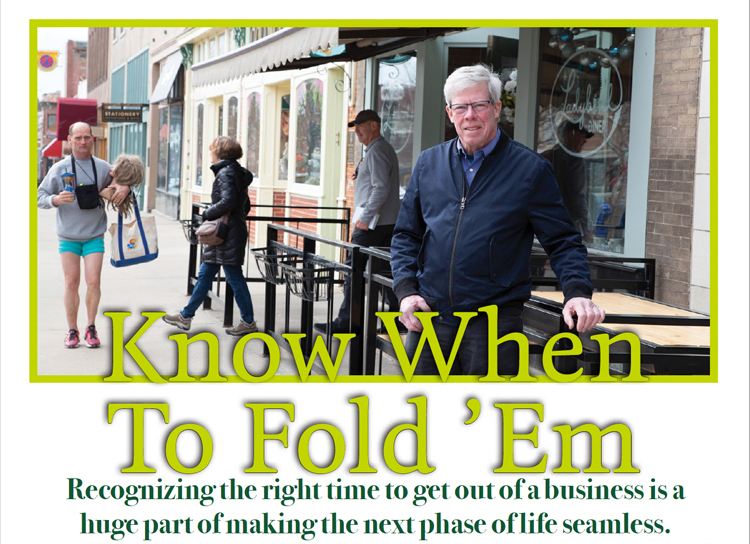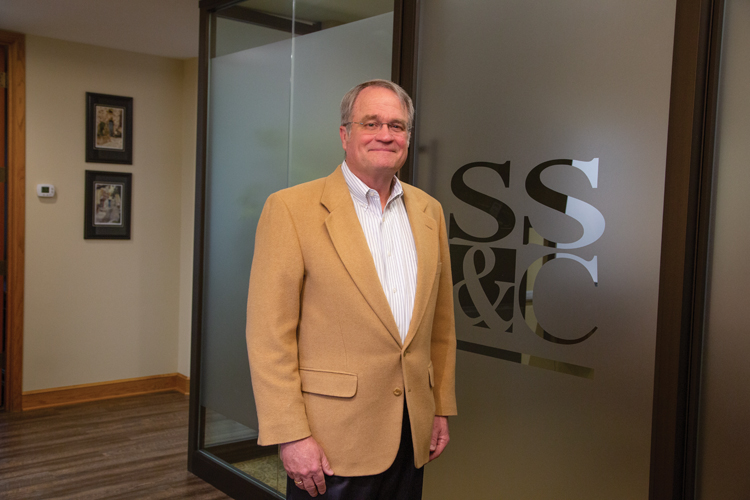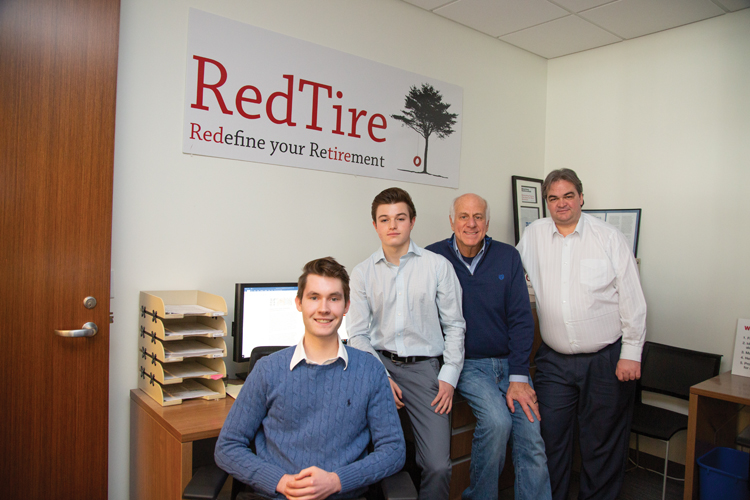Recognizing the right time to get out of a business is a huge part of making the next phase of life seamless.
| 2019 Q1 | story by Bob Luder | photos by Steven Hertzog

Bob Schumm, hanging out on Mass St.
As longtime owner of two venerable Mass Street eateries, there probably isn’t anyone better versed on how to run businesses and run them successfully in Lawrence than Bob Schumm.
Veteran residents of the area are familiar with the Mass Street Deli, located farther south on the city’s main drag, and Buffalo Bob’s Smokehouse a few blocks north. Schumm owned each enterprise for 37 years and also served three terms as Lawrence mayor while doing so. In more than four decades in the restaurant business, you learn more than a few tricks of the trade.
That includes when to get out. As the classic country song goes, “You gotta know when to hold ’em, know when to fold ’em,” and as the millennium entered its second decade, Schumm surveyed the local restaurant landscape and decided the time was right to transition out of the only business he’d known.
“It was a combination of things,” Schumm says. “I was ready to retire. The restaurant market was softening. It was getting too crazy. Buildings that had longtime restaurants in them were being retrofitted or torn down.”
Schumm’s decision to step away from the restaurant business presented a whole other set of questions and options that face business owners every day who decide it’s time to transition to another phase of life. Do I sell the business whole? Break it up and sell it in pieces? Hand it down to children or other relatives? Walk away entirely?
Fortunately for Schumm, his answers presented themselves readily and clearly. His children, who all had worked in one or both of the restaurants at one point or another in their young lives, went on to their own careers outside the food-service business. And Schumm found there was no shortage of eager buyers.
In 2010, he sold the building that housed Mass Street Deli, which he’d owned since 1973, and all the restaurant’s equipment. Today, Genovese, an Italian restaurant, resides in the space.
“I didn’t want to sell the building,” Schumm says, “but as they say, I was made an offer I couldn’t refuse.”
He held on to Buffalo Bob’s Smokehouse for four more years, but, as he put it, “In 2014, I decided it was time to go do other things. I’d been in the restaurant business 44 years. That’s a long career.”
He liquidated Buffalo Bob’s but kept the building. The space was divided into two new restaurants—Mass Street Fish House, at 719 Massachusetts St., and Lady Bird Diner, at 721 Massachusetts St. There also is a mercantile/clothing establishment at 717 Mass, and Schumm rents 31 office spaces on the second floor of the building, adding to his second career of managing commercial real estate and making for a nice retirement.
“Really, I’m still in the restaurant business,” he says, laughing. “It’s just that, now, I’m at the top of the food chain.”
Schumm says it was to his advantage that his children weren’t interested in assuming ownership of the restaurants.
“I could make my decision based solely on the facts and keep emotion out of it,” he says.
Schumm’s transition out of his longtime businesses proceeded smoothly, but, the fact is, not everyone is so lucky.

Gary Summers, SS&C Solutions
Start Thinking About It Early
Gary Summers, a certified exit planning advisor with SS&C Solutions Inc., with offices in Lawrence, Topeka, Meriden, Shawnee and Salina, understands that most people are so excited about starting a company then so immersed in the day-to-day functions, contemplating an exit strategy becomes an afterthought. But he encourages business owners to develop a solid exit strategy sooner than later.
“It can be daunting, and a lot of people don’t think about it,” Summers says. “We encourage people to start early. There is a lot to consider.”
Summers recommends the formation of an exit plan—or, at least thinking about formulating one—as many as 10 years from when the owner plans to step away. After all, he says it’s only the single most critically important financial event one experiences in life. Some tax and wealth-building strategies take time. Starting earlier creates more options and produces better outcomes. The sooner a good exit plan is hatched, the higher probability there is for creating lasting wealth for the owner and family.
Summers explains that a thorough and well-executed exit plan can allow the business owner to get maximum value for the business during the transition, reduce risk and ensure the ability to remain in control of the process until ready to move. What’s your business worth? What do you want it to be worth? How do you recognize when it’s the right time to leave? All of these questions can be answered with a solid exit plan that includes a team of advisors, including a lawyer, accountant, financial advisor, insurance professional and tax advisor.
One of the myriad reasons Summers, who acquired SS&C Solutions in October 1984, knows of what he speaks is that he recently went through an exit strategy of his own. Just last December, he sold his remaining shares of stock back into the company’s employee stock-ownership plan.
“There’s no better teacher than the experience of going through that,” he says. “I’m functioning now as an employee and working more with companies on succession plans.”
Both of Summers’ children—daughter Michele Hammann and son Greg—work for the company. In fact, Summers technically works for his daughter today.
Both Summers children are employee shareholders in SS&C Solutions, and Summers says it was an important part of his exit plan to sell his stock interest back to all company employees, not just those in his own family.
“I’ve always been a proponent of employee ownership plans,” he says. “I brought that concept from Oklahoma City (where he was a CPA for a large firm back in the early 1980s). Before even talking to my kids about succession plans, we talked about doing this here.”

L to R: Jordan Hulet, Mark Harrington, Wally Meyer (Director of entrepreneurship programs at KU and Director of the RedTire program) and Denton Zeeman of KU’s Red Tire
REDefine Your ReTIREment
Small, rural companies in the area and throughout Kansas that have no succession plan in place can find assistance with RedTire, one of the entrepreneurship programs at the University of Kansas School of Business. Wallace Meyer Jr., director of entrepreneurship programs at KU, started RedTire about five years ago after learning during a visit to western Kansas about the problem of small- to medium-sized companies shuttering because of lack of succession plans.
“The problems were not with the businesses themselves,” Meyer says. “The baby boomer generation worked very hard to establish these small to mid-size businesses, and now it’s time that they want to retire. But they couldn’t find buyers.”
Enter RedTire, which acts as a matchmaker between qualified Kansas Regents school graduates and alumni who have the expertise and ambition to run rural businesses where existing owners desire an exit.
“Keeping these businesses alive is particularly important for smaller Kansas towns that depend on the essential services these businesses provide,” Meyer says. “Not only do communities lose essential services when these businesses shutter, they also lose the tax base.”
He continues, “Being an entrepreneur, the thought occurred, we have a void here that needs to be filled. And here we are (at KU) with a reservoir of talent. RedTire is the connection between the reservoir and void.”
RedTire screens businesses to identify purchase opportunities and alumni or graduating candidates as replacement owners. It matches qualified replacement managers with those opportunities. It provides financial projections and valuation for selling businesses, helps in negotiating purchases and monitors managers through successful transitions.
And it’s all done by KU business students.
“It provides a great learning experience for students,” Meyer says. “Students prepare financial projections and valuation of businesses. I think one of the reasons we’re so successful is that there’s a natural credibility. All of our students are completely objective partners.”
There is no cost for businesses and buyers to participate in RedTire. Expenses are covered by a grant from the Economic Development Administration with the U.S. Department of Commerce and the KU School of Business.
As of Aug. 17, 2018, the program has had 56 completed transactions totaling gross revenues of $57 million and 465 jobs saved. It’s had 177 program participants and currently is assisting 121 firms throughout the state.
Valley Feed & Supply, located in Bonner Springs, is one of those successfully completed transactions. The business had been in the Stubbs family since 1923. But when Neal and Marty Stubbs, third-generation owners, decided it was time to sell and retire, their children had their own careers, and they didn’t have a buyer. Through a letter received through the KU Alumni Association, they contacted RedTire in August of 2014.
“(RedTire) did a very thorough evaluation and appraisal of the business,” Neal says. “Through their website, we found our buyer.”
Stubbs says he closed on the sale of Valley Feed & Supply in January 2018.
“Because we did spend quite a lot of time on this, it helped me in transitioning out of the business,” Neal says.
Changing Landscape of Business
Some businesses, such as Valley Feed & Supply, transition because it’s the owners’ choice. Still other owners are told when it’s time to step away by economic and cultural changes that make staying near impossible.
It was announced late last year that Prairie Patches, a mainstay at 821 Massachusetts St. for 26 years and in business for about 45, was closing in early 2019. Cinda Garrison, who owned and operated the variety store throughout, credits her age (76) and a pair of aching knees as reasons for selling her building and liquidating all her merchandise. But as she tells the Lawrence Journal-World in November of last year, a changing business landscape also led to her decision.
“I don’t know who my customer base is anymore,” Garrison says. “Buying habits have changed so much over the years. I don’t sell a lot of things that you need but rather stuff that you want. My older women don’t really want stuff anymore, and my young women don’t really want things either. They want experiences.”
Garrison says she doesn’t know what kind of business will go into the space at 821 Mass. She thinks the market for personalized retail items, like clothing and other gear, will bounce back. Things like that always come and go in cycles, she says. But she knows she won’t be a part of it. Her transition out is complete. For those who work with the RedTire program, SS&C Solutions or any other number of ways, when it comes to leaving a company you’ve helped build and grow, some transitions will go more smoothly than others. All probably come with at least some degree of melancholy and nostalgia.
“You can say it is with much sadness that I’m closing,” Garrison tells the Journal-World. “I love people and love my customers, and love being in downtown Lawrence. But at some point, it becomes time.”
